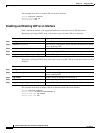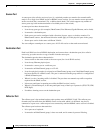
20-6
Catalyst 2950 Desktop Switch Software Configuration Guide
78-11380-05
Chapter 20 Configuring SPAN and RSPAN
Understanding SPAN and RSPAN
If a port is added to a monitored EtherChannel group, the new port is added to the SPAN source port
list. If a port is removed from a monitored EtherChannel group, it is automatically removed from
the source port list. If the port is the only port in the EtherChannel group, the EtherChannel group
is removed from SPAN.
If a physical port that belongs to an EtherChannel group is configured as a SPAN source, destination,
or reflector port, it is removed from the group. After the port is removed from the SPAN session, it
rejoins the EtherChannel group. Ports removed from an EtherChannel group remain members of the
group, but they are in the down or standalone state.
If a physical port that belongs to an EtherChannel group is a destination or reflector port and the
EtherChannel group is a source, the port is removed from the EtherChannel group and from the list
of monitored ports.
• QoS—For ingress monitoring, the packets sent to the SPAN destination port might be different from
the packets actually received at the SPAN source port because the packets are forwarded after
ingress QoS classification and policing. The packet DSCP might not be the same as the received
packet.
• Multicast traffic can be monitored. For egress and ingress port monitoring, only a single unedited
packet is sent to the SPAN destination port. It does not reflect the number of times the multicast
packet is sent.
• A secure port cannot be a SPAN destination port.
SPAN and RSPAN Session Limits
You can configure (and store in NVRAM) one local SPAN session or multiple RSPAN sessions on a
switch. The number of active sessions and combinations are subject to these restrictions:
• SPAN or RSPAN source (rx, tx, both): 1 active session limit. (SPAN and RSPAN are mutually
exclusive on a source switch).
• RSPAN source sessions have one destination per session with an RSPAN VLAN associated for that
session.
• Each RSPAN destination session has one or more destination interfaces for each RSPAN VLAN that
they support.
• RSPAN destination sessions are limited to two, or one if a local SPAN or a source RSPAN session
is configured on the same switch.
Default SPAN and RSPAN Configuration
Table 20-1 shows the default SPAN and RSPAN configuration.
Table 20-1 Default SPAN and RSPAN Configuration
Feature Default Setting
SPAN state Disabled.
Source port traffic to monitor Both received and sent traffic (both).
Encapsulation type (destination port) Native form (no encapsulation type header).


















